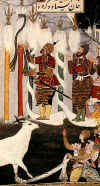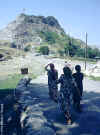Historic Evidence about "Shamanic Practices"
There is a variety of evidence which allows us to document the existence of such rituals in earlier centuries especially amongst the Mongols and their heirs. The Secret History of the Mongols, which records their early history in the twelfth and thirteenth centuries, describes several important tribal gatherings at the "Branching Tree," apparently a distinctive and venerated site. On one such occasion when they agreed on the elevation of one Qutula as khan, the anonymous author notes: "As for the rejoicing of the Mongols, they were wont to rejoice dancing and feasting. Having raised up Qutula as khan, they danced round about the Branching Tree of Qorqonagh Valley until there was a ditch up to their ribs, until there was dust up to their knees" [Cleaves transl., pp. 13-14]. Later the text speaks of sacrifices to ancestors which apparently involved "burning food in the earth" (p. 19). Some locations were revered as tribal homeland, to which one would return, where one might take refuge, where one's ancestors were buried. One such location was Mount Burqan Qaldun, where the young Temüjin (the future Chingis Khan) was able to escape his enemies, after which he vowed:
"Every morning I shall sacrifice unto Mount Burqan. Every day I shall pray unto it. Let the seed of my seed observe this": over against the sun he hanged his girdle on his neck, hanged his hat in his hand, struck his hand into his breast, and, kneeling nine times toward the sun, offered a sprinkling of mare's milk and a prayer [p. 37].
In describing the customs observed by the Mongol ruler Quibilai Khan in the late thirteeth century even after he had conquered China and been exposed to a variety of other cultural influences, Marco Polo relates how the emperor kept a large herd of white horses, whose milk could be drunk only by members of the imperial lineage and one tribe which had special imperial favor. Polo goes on to say:
The astrologers and idolaters have told the Great Khan that he must make a libation of the milk of these mares every year on the 28th August, flinging it into the air and on the earth, so that the spirits may have their share to drink. They must have this, it is said, in order that they may guard all his possessions, men and women, beasts, birds, crops, and everything besides. [Latham transl., p. 109.]

The first Mughal emperor Babur was as proud of his Mongol ancestry as he was confident in his judgment as a practitioner and critic of sophisticated formal islamic poetry. In his early sixteenth-century memoirs he writes about a ritual in which he participated near Tashkent in 1502 when setting out on campaign with his maternal uncle Sultan Mahmud Khan. A sixteenth-century miniaturist very carefully illustrated the scene:
According to Moghul custom the yak-tail standards were acclaimed. The khan dismounted, whereupon nine standards were set up before him. A Moghul tied a long piece of white cloth to a cow's shank and held the other end in his hand. Another three long pieces of cloth were tied to the standards below the yak tails and wrapped down to the bottom of the standard poles. The end of one piece of cloth was brought for the khan to stand on. I stood on the end of another, and Sultan-Mahmud Khanika stood on the third. The Moghul took hold of the cow's shank to which the cloth was tied, said something in Mongolian, and, facing at the standards, made a sign. The khan and all those standing by threw their koumiss [fermented mare's milk] toward the standards. All at once the clarions and drums were sounded, and the army standing in ranks let out whoops and shouts. Three times they did this... [Thackston transl., p. 136.]
Many of the shamanic rituals involve (in the words of Devin DeWeese) "offerings to the ancestral spirits in their various forms, intended to preserve the health and continuity of the family and community." (Islamization and Native Religion in the Golden Horde, p. 37.) DeWeese argues that it was precisely this traditional emphasis on ancestral worship which made Central Asian Turkic peoples receptive to Islam in its Sufi variants. While the conversion tales he cites date to long after the events, it is intriguing to picture from them how Sufi holy men might well have "performed miracles" in the context of traditional ritual celebrations and thus appealed to the shamanist Mongols of the Golden Horde in the fourteenth century. Worship of such holy men at their shrines (mazars) might then develop as the equivalent of the veneration previously reserved for tribal ancestors. That is, "the acknowledgement of a Muslim saint as one's individual or communal ancestor marks a singularly vital assimilation of Inner Asian and Islamic values" (DeWeese, p. 56). In many traditional Central Asian oral epics, including the Kyrgyz epic Manas, old parents of a future hero go to a mazar (grave or shrine) and ask for a child. Even today, those who are trying to have children go to sacred places, not just to mazars, but to springs, rivers, or a lonely tree and sacrifice a sheep.


 An example of a Muslim shrine in Central Asia which is especially venerated by women hoping to
give birth to healthy children is that on "Solomon's (Suleiman's) Mountain" in Osh, Kyrgyzstan.
The shrine marks the supposed grave of the wise ruler Solomon. Along the paths ascending the
mountain, the trees and bushes are draped with "prayer flags," small strips of cloth that have
been tied to them. Women who ascend to the shrine on top crawl though an opening across the
holy rock. Several years ago, Solomon's Mountain was the scene of a surprise visit by then
Prime Minister of Pakistan, Benazir Bhutto, who came to Osh, it seems, specifically to pray
for a successful outcome of her pregnancy.
An example of a Muslim shrine in Central Asia which is especially venerated by women hoping to
give birth to healthy children is that on "Solomon's (Suleiman's) Mountain" in Osh, Kyrgyzstan.
The shrine marks the supposed grave of the wise ruler Solomon. Along the paths ascending the
mountain, the trees and bushes are draped with "prayer flags," small strips of cloth that have
been tied to them. Women who ascend to the shrine on top crawl though an opening across the
holy rock. Several years ago, Solomon's Mountain was the scene of a surprise visit by then
Prime Minister of Pakistan, Benazir Bhutto, who came to Osh, it seems, specifically to pray
for a successful outcome of her pregnancy.
© 2001 Elmira Köçümkulkïzï and Daniel C. Waugh.
Silk Road Seattle is a project of the Walter Chapin Simpson Center for the Humanities at the University of Washington.